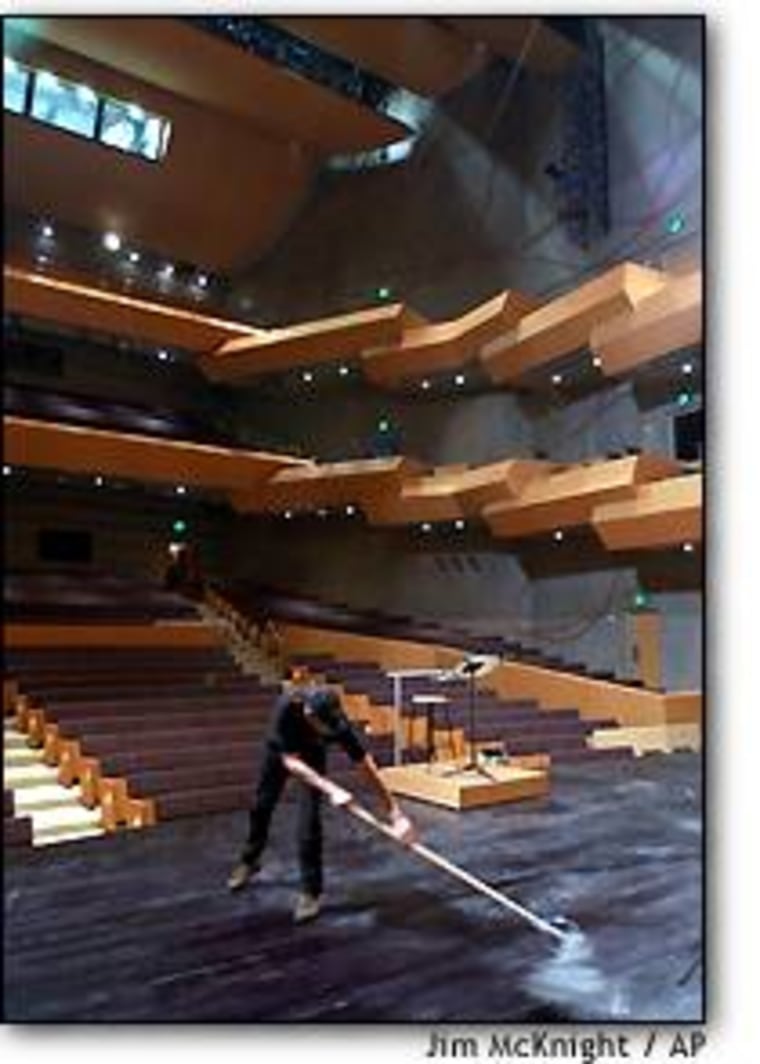The shimmering steel canopy of the new performing arts center captures the Catskill Mountains in the background and the tree line of the heavily wooded Bard College campus. There’s nothing like it around here. The $62-million Richard B. Fisher Center for the Performing Arts, designed by megastar architect Frank Gehry, has drawn photo snapping tourists even before an audience has seen the first performance.
THE BUILDING OPENS to the public this weekend and has caused a stir in this quaint corner of the Hudson Valley, 90 miles north of New York City.
The way it fits into the landscape was accidental, its architect said. “You push something into being, create an environment,” said Gehry, 74, who likes the description of the Fisher Center as a “fat building.”
“It so clearly states it’s packed with stuff, bulging with ideas, feelings. That’s kind of what I’m trying to do,” he said.
Gehry took on the project in 1997, before he finished the Guggenheim museum in Bilbao, Spain, acknowledged as one of the world’s great modern buildings.
“Someone said he’s principally known as an urban architect,” Bard president Leon Botstein said. “This is a spectacular example of how he deals with a bucolic, rural parklike setting.”
MUSICAL INSPIRATION
The undulating steel canopy — the center’s most striking feature — covers two theaters: a main theater that seats up to 950 and a black box theater for 200.

The shape of the main concert hall’s interior was inspired by a lyre and that’s where Gehry’s design began. He was playing with those curves and “started to use them on the outside in a more flamboyant or generous way,” he said.
The main Sosnoff Theater features a movable concert shell paneled in Douglas fir that can accommodate opera, drama, dance and symphonies. Playful decorative squiggles also constructed of Douglas fir loop on the concrete walls of the main theater. Gehry said wood was needed to break up the concrete surface for the acoustics and he quickly scribbled them on a piece of paper.
Walls move, towers come down. There are trap doors, an instant orchestra pit, massive rehearsal spaces and a huge area to construct scenery.
“The building is defined from the space inside,” said Botstein, who was to conduct the American Symphony Orchestra at the Fisher Center Friday. “The building is so large because it takes a great architect to make it beautiful. It could have easily have been a clunky, windowless bomb shelter.”
REFLECTIONS OF THE SKY
Gehry said steel was chosen because unlike copper and zinc, it will retain its reflection years from now.
“The big canopy in front started out as canopy to protect people at the door like a porch. It then becomes a shield.” On a sunny day, it reflects the sky. “On a rainy day, it disappears into the sky. It just disappears.”
The design was mainly chosen to meet the school’s needs, Gehry said.
The school will celebrate the building with two weekends of performances. On Friday, Gustav Mahler’s Third Symphony, conducted by Botstein with mezzo-soprano Nancy Maultsby and the Young People’s Chorus of New York City, was to be performed. A production of Jean Racine’s “Phedre” will be performed five times over the two weekends.
The Merce Cunningham Dance Company will be featured May 1, while Elvis Costello will appear in a sold-out performance with the Charles Mingus Orchestra on May 3.
On the seats in the main concert hall, the names of the students who are graduating are woven into the cushions, a symbolic gesture to pay tribute to the college’s tradition of nurturing an appreciation of the arts.
“The people with whom we could not do without,” Botstein said.© 2003 Associated Press. All rights reserved. This material may not be published, broadcast, rewritten or redistributed.